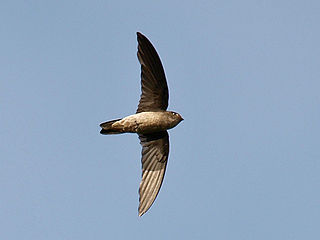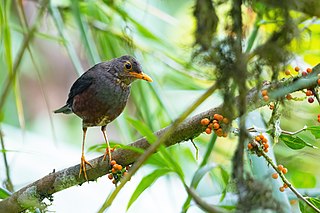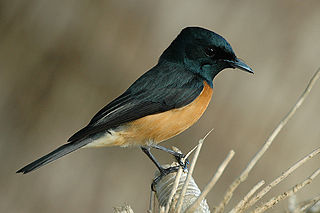
Swiftlets are birds from the four genera Aerodramus, Collocalia, Hydrochous and Schoutedenapus, which form the tribe Collocaliini within the swift family Apodidae. The group contains around thirty species mostly confined to southern Asia, south Pacific islands, and northeastern Australia, all within the tropical and subtropical regions. They are in many respects typical members of the Apodidae, having narrow wings for fast flight, with a wide gape and small reduced beak surrounded by bristles for catching insects in flight. What distinguishes many but not all species from other swifts and indeed almost all other birds is their ability to use a simple but effective form of echolocation to navigate in total darkness through the chasms and shafts of the caves where they roost at night and breed.

Aerodramus is a genus of small, dark, cave-nesting birds in the Collocaliini tribe of the swift family. Its members are confined to tropical and subtropical regions in southern Asia, Oceania and northeastern Australia. Many of its members were formerly classified in Collocalia, but were first placed in a separate genus by American ornithologist Harry Church Oberholser in 1906.

The Pacific swallow is a small passerine bird in the swallow family. It breeds in tropical southern Asia and the islands of the south Pacific. It is resident apart from some local seasonal movements. This bird is associated with coasts, but is increasingly spreading to forested uplands. The hill swallow and the welcome swallow were formerly considered conspecific.

The island thrush is a common forest bird in the thrush family. Almost 50 subspecies have been described, ranging from South East Asia and Melanesia, to Samoa, exhibiting great differences in plumage. Several subspecies are threatened and three have already become extinct.

The edible-nest swiftlet, also known as the white-nest swiftlet, is a small bird of the swift family which is found in Southeast Asia. Its opaque and whitish bird nest is made exclusively of solidified saliva and is the main ingredient of bird's nest soup, a delicacy of Chinese cuisine.

The Ameline swiftlet, also known as the grey swiftlet, was formerly considered as a subspecies of the uniform swiftlet. It is endemic to the Philippines. Its natural habitat is tropical moist lowland forests. Despite some fears around conservation, the species remains a Least-concern species.

The glossy swiftlet is a species of swift in the family Apodidae. It is found on the Indonesian island of Sulawesi and eastwards to New Guinea, the Bismarck Archipelago and the Solomon Islands.
The mountain swiftlet is a species of swift in the family Apodidae. It is endemic to the island of New Guinea and the nearby islands of Karkar, Yapen and Goodenough. It was once placed in the genus Collocalia but has been moved, with many others, to Aerodramus. The species is divided into three subspecies, with the nominate, A. h. hirundinacea ranging over most of New Guinea, the subspecies A. h. excelsus occurring over 1600 m in the Snow Mountains and Cartenz peaks of Irian Jaya and A. h. baru being restricted to Yapen Island. It occurs in alpine areas from 500 m to the treeline. Its natural habitat is tropical moist montane forests and other mountainous habitats in New Guinea. It also occurs in lower numbers in the lowlands near hills.

The rusty-winged starling is a species of starling in the family Sturnidae. It is found in the Santa Cruz Islands and Vanuatu.

Pinon's imperial pigeon or Pinon imperial pigeon is a species of bird in the family Columbidae. It is found in New Guinea. The species is named after Rose de Freycinet née Pinon. Several subspecies have been designated:

The white-bellied cuckooshrike is a species of bird in the family Campephagidae. It is found in Australia, the Moluccas, New Guinea and the Solomon Islands.

The paradise drongo or ribbon-tailed drongo is a species of bird in the family Dicruridae. It is endemic to New Ireland in the Bismarck Archipelago, Papua New Guinea. With a total length of 51 to 63 cm and body mass of 130 g (4.6 oz), this may be the largest species of drongo.

The island monarch is a species of bird in the family Monarchidae. It is found from Sulawesi to the Solomon Islands. Its natural habitats are subtropical or tropical moist lowland forests and subtropical or tropical moist montane forests.

The hooded monarch is a species of bird in the family Monarchidae. It is found on New Guinea. Its natural habitat is subtropical or tropical moist lowland forests.

The Vanikoro flycatcher is a species of monarch flycatcher in the family Monarchidae. It has a slightly disjunct distribution, occurring on Vanikoro island and in Fiji.

The black sunbird is a species of bird in the family Nectariniidae. It is found in eastern Indonesia and New Guinea. Its natural habitats are subtropical or tropical moist lowland forest and subtropical or tropical mangrove forest.

The grey whistler or brown whistler, is a species of bird in the family Pachycephalidae. It is found in northern Australia and New Guinea. Its natural habitats are subtropical or tropical moist lowland forest and subtropical or tropical mangrove forest.

The variable goshawk is a bird of prey native to Indonesia, Papua New Guinea and the Solomon Islands. It was recently elevated to species status, and was previously lumped together with the grey goshawk. This species was formerly placed in the genus Accipiter.

The Apodinae are a subfamily of swifts and contain the following species:



















